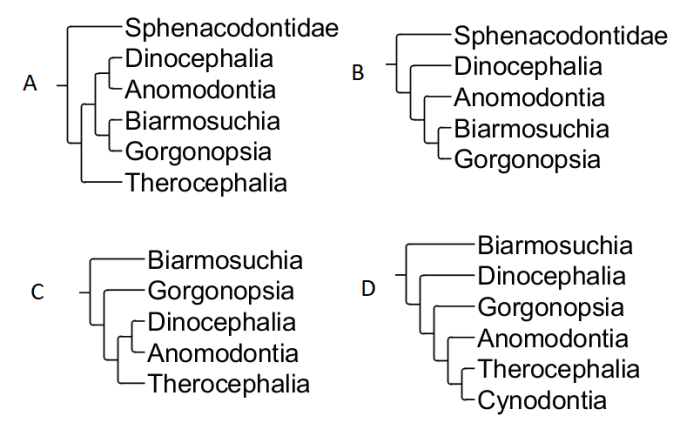Today I want to talk about one of the more unappreciated areas of phylogenetic uncertainty. Most of the time, you’ll see therapsid phylogeny depicted as a pectinate arrangement of Biarmosuchia, Dinocephalia, Anomodontia, Gorgonopsia, and Therocephalia as successively closer to Cynodontia.

This is the phylogeny shown in review papers such as Rubidge and Sidor (2001) and repeated in textbooks such as Kemp (2005) and Benton (2005). Wikipedia uses it. More recently, it has become common to depict it as ambiguous whether anomodonts or gorgonopsians are closer to cynodonts, as in Angielczyk (2009) and this TetZoo article, but the tree remains otherwise the same.
But if you look at the phylogenies in the literature, what do you see?

Phylogenies summarized from: A. Cisneros et al. 2015 B. Amson and Laurin 2011. C. Kammerer and Smith 2017. D. Huttenlocker and Sidor 2016.
You see a lot of different topologies, but nothing that matches the traditional arrangement perfectly. In fact, I can’t think of a single paper from the last several years which matches the “consensus” view of therapsid phylogeny—the only one I figured that gets close has anomodonts closer to cynodonts than gorgonopsians, which at least is acknowledged as a possibility in some more recent cladograms. Now, to be fair, some of these cladograms (C and D) are taken from outgroups of phylogenetic analyses that were primarily focused on the internal relationships of one specific group, and might not have had the data to accurately resolve the relationships outside of the group focused on. However, the overall variety in therapsid phylogenies is still interesting. Why is there this lack of consensus?
I’m not sure, and one of my goals going forward with this blog will be to look into just what’s going on here. More as this story develops.
Amson E., Laurin M. 2011. On the Affinities of Tetraceratops insignis , an Early Permian Synapsid. Acta Palaeontologica Polonica 56:301–312. DOI: 10.4202/app.2010.0063.
Angielczyk KD. 2009. Dimetrodon Is Not a Dinosaur: Using Tree Thinking to Understand the Ancient Relatives of Mammals and their Evolution. Evolution: Education and Outreach 2:257–271. DOI: 10.1007/s12052-009-0117-4.
Benton MJ. 2005. Vertebrate palaeontology. Malden, MA: Blackwell Science.
Cisneros JC., Abdala F., Jashashvili T., de Oliveira Bueno A., Dentzien-Dias P. 2015. Tiarajudens eccentricus and Anomocephalus africanus , two bizarre anomodonts (Synapsida, Therapsida) with dental occlusion from the Permian of Gondwana. Royal Society Open Science 2:150090. DOI: 10.1098/rsos.150090.
Huttenlocker AK., Sidor CA. 2016. The first karenitid (Therapsida, Therocephalia) from the upper Permian of Gondwana and the biogeography of Permo-Triassic therocephalians. Journal of Vertebrate Paleontology 36:e1111897. DOI: 10.1080/02724634.2016.1111897.
Kammerer CF., Smith RMH. 2017. An early geikiid dicynodont from the Tropidostoma Assemblage Zone (late Permian) of South Africa. PeerJ 5:e2913. DOI: 10.7717/peerj.2913.
Kemp TS. 2005. The origin and evolution of mammals. Oxford ; New York: Oxford University Press.
Rubidge BS., Sidor CA. 2001. Evolutionary patterns among Permo-Triassic therapsids. Annual Review of Ecology and Systematics 32:449–480.